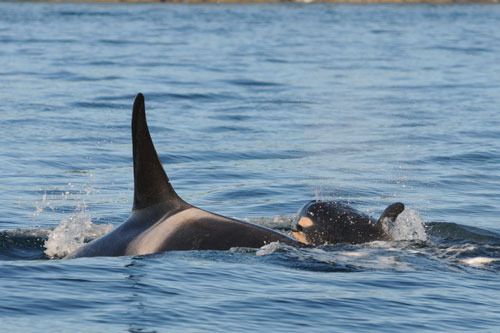The newborn calf in J-pod is a welcomed addition to the population in peril, but only time will tell who its mother is.
The Center for Whale Research confirmed seeing and photographing 42-year-old J-16 with, presumably, her newborn baby, off the south shores of North Pender Island in Canadian waters Dec. 30. The baby, known as J-50, is the second calf to be born in 2014, after a two-year lull of no births among the Southern Resident killer whales.
The calf appeared to be healthy and energetic, swimming alongside its presumed mother. However, researchers immediately recognized some peculiarity surrounding its birth.
J-16 was not expected to be carrying a calf due to her advanced age and no other female has given birth at over 42 years of age in the four decades of demographic field studies of the Southern Resident orcas.
Researchers speculated that J-16’s daughter, J-36, could be the mother. At age 16, J-36 is in her prime for breeding.
At the time the newborn was first sighted swimming alongside J-16, J-36 appeared to be missing. Ken Balcomb, founder of the Center for Whale Research, feared the worst.
“Thank goodness she was alive,” he said. “The issue of who is the mother of J-50 may be settled the next time we encounter these whales. Or, it may take some time.”
The birth of J-50 comes at the end of a rocky year for the Southern residents. The population, which was declared endangered in 2005, suffered four deaths in 2014. The birth of J-50 brings it back up to 78, a 30-year low nonetheless.
Oddities surrounding the birth of J-50 appeared to Balcomb and his team when they discovered that the newborn had teeth marks on its dorsal fin. This could indicate a difficult birth, in which another whale may have had to use its mouth to help pull the baby out of its mother’s uterus.
Balcomb said the baby also exhibited unusual behaviors in the first days after its birth. For the first week or so of life orca calves and their mothers usually maintain eye contact while swimming along. For the first month of life, the two are relatively inseparable.
Neither of these normal behaviors were displayed by J-50. He said the calf was seen swimming away from J-16 and had to be corralled back to its presumed mother by other members of J-pod.
These behaviors could indicate that J-36 is the mother, and the calf was swimming away because its mother was several miles behind.
If J-36 is the mother, this would be her first known calf. But because orcas can spontaneously abort a fetus, it’s impossible to rule out previous pregnancies.
While the nearly full-term pregnant female, J-32, was found dead in December with the first “known” calf was in her uterus, her ovaries had evidence of prior pregnancies, Balcomb said.
Even when the question of who is the mother of J-50 is answered, the fate of the baby orca will remain uncertain. Its chance for survival depends on the mother having a sufficient food supply. Orca calves need to nurse for about one year. If there’s not enough food, there’s not enough milk for the calf.
“I’m emotionally tied to trying to get our politicians and the public to attend to the food supply,” Balcomb said. “The whales simply will not be here if they don’t have food.”



